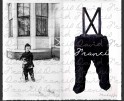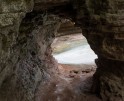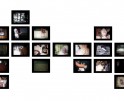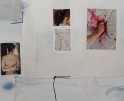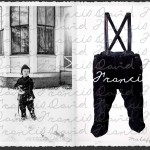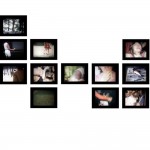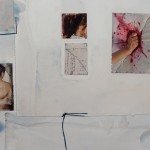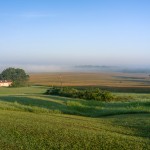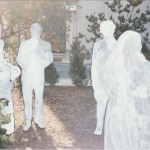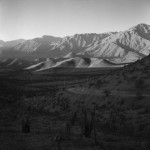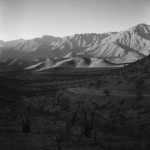Success Stories: Bruce Haley
A couple of years ago, I wrote this about Bruce Haley on Lenscratch:
Bruce Haley on his Nevada property, June 2011
“The world of Bruce Haley is not for the faint-hearted. Now living in Northern California, Bruce has traveled the globe photographing some of the darkest moments that only the intrepid want to face. “I wander toward the world‘s margins, the dark places, places of solitude, rural landscapes, wasteland. What this says about me is unimportant; what one encounters in such places is the heart of the matter. For it is there that life is unvarnished and vital, where the margins offer the occasional glimpse of a darkly-splendid world.”
“For his intense and meaningful work, Bruce has received the Robert Capa Gold Medal for the coverage of Burma’s bloody ethnic civil war, and was nominated for a Pulitzer Prize for his work on famine in Somalia. His website is a testament to his vision, intelligence, and courage in telling stories that need to have a witness. His site also contains a terrific interview with Joerg Colberg, and Bruce’s own Tao of War Photography. The world needs more photographers like Mr. Haley. Not only is he committed to revealing the truth, he is committed to his craft and his community. He generously gives back, sharing his advice and expert eye with those who stand in his long shadow.”
Since that last post, Bruce has been busy, not only exploring fatherhood, but once again traveling the globe to document and visually explain our difficult world. Revisiting his website had me biting my nails, worrying about his safety, and feeling incredible gratitude for what he has put himself through to tell stories, no matter how horrendous or challenging.
His new monograph, SUNDER, has recently been published by Charta/Daylight.The book is a stunning exploration of the former USSR and other Iron Curtain countries, but equally as interesting are the accompanying essays, in particular, the wonderful piece by Andrei Codrescu (you may be famliar with his essays read on NPR), and by Kirsten Rian. I am thrilled to share this work and interview as a Success Story, one of the many that Bruce has already accomplished and will undoubtedly achieve in the future.
“Produced between 1994 and 2002, the images in SUNDER sweep the viewer along on a far-reaching journey through numerous former USSR and Iron Curtain countries, stopping at landscapes of ruin and moments of grace in equal measure. Haley’s explorations were intuitive, responding to a deep curiosity to taste the last drops of the would-be Utopian ideology that dominated global politics during the first thirty years of his life. Using black and white film, the notion of remnants and transition would sustain Haley’s photographic investigation for some eight years. The resulting images present a stark perspective of the collapse of the communist empire. Haley’s photographs are bleak and brimming with the realism that only a photographer as seasoned as he could achieve. Given the contrast with Haley’s conflict-based coverage, which was dominated by lush color imagery depicting the most horrific acts of violence imaginable, it seems as though this personal project is as much a portrait of the photographer himself as it is an invaluable historical archive.”
Bruce, Congratulations on an amazing project and book. What drew you to the subject and how did you align with Daylight and Charta Books?
Thank you for your kind words, Aline. I’m so self-critical, so brutal on myself when it comes to my work, that even after 23 years in the field it is always a pleasant surprise when anyone says something nice about what I do… I’ve always been my biggest critic and worst promoter….
As for what drew me to the subject in SUNDER, that’s a really tough question – mostly because the subject, finally and much to my surprise, turned out to be life itself (as trite and cliched as that may sound). In the beginning it had this extremely vague overarching label of “post-communist project,” and this seemed to be the pole star from which I navigated, as it went through its various labyrinthine twists and turns; later I would jokingly nickname it my “octopus project,” since it kept sprouting all of these various “arms,” as I branched out in different directions and explored more and more diverse subject matter. But in the end, when I did my final edit and sequence for the book, I realized that the “post-communist” label really was the crescent rather than the whole of the moon, that the subject was simply life in its various manifestations – light and dark, beauty and ugliness, joy and pain, strength and weakness… devastated industrial landscapes and rural agrarian communities, often nearly side-by-side… where we live, what we do to each other, what we do to the land we inhabit… moments of grace and moments of trial… I wanted my edit and sequence, and the book as a whole package, to really reflect this polarity…
My alignment with Daylight and Charta came about through my friendship with one of Daylight’s founders, Taj Forer. We met when we were both doing portfolio reviews at the San Francisco Art Institute, and we struck up an instant friendship. When Daylight wanted to launch a book program, Taj knew I was in the process of assembling my post-communist project into book form, and he already knew the work and loved it, so he asked if I would like to be in the vanguard of their nascent book effort. I said yes without hesitation, as I consider it a rare treat in this business to work with someone who I trust unflinchingly – it doesn’t happen often… Taj had done his book Threefold Sun with Charta, so he approached them as a co-publisher and they bit.
Of course this is the “Cliff’s Notes” version, the fast connect-the-dots story… In reality, I had my personal vision of what this book should be – I had already assembled the contributing writers, done my edit and sequence, etc. etc., so it was for the most part a completed package (minus the actual design work), ready to be dropped into a publisher’s lap… the flip side of the coin, however, is that I was ready to walk away, or shelve it entirely, if there was any editorial heavy-handedness… for better or for worse, I can be very pig-headed that way – I live and work from a place of real isolation, and have very specific ideas about how I want my work presented… of course I realize the school of thought that says photographers are rarely their own best editors, but what the hell… anyone who has done much magazine work realizes the powerlessness, and frustration, regarding how your work ends up in such venues… in book form, in my opinion at least, the whole shootin’ match should feel like it’s yours…
In the end, both Daylight and Charta were the ones who gave me this freedom, who wanted it the way it was – the contributing writers stayed the same, my ideas on layout and design remained, my edit and sequence stayed exactly the same… then again, I don’t want it to sound like I did this alone – many other people worked really hard and brought great things to the finished project, of course.. I say this mostly just to shoulder the blame – the final package is exactly how I had originally envisioned and wanted it to be, so any slings and arrows, darts and various projectiles, rotten tomatoes, etc., should be launched squarely in the direction of me and my stubbornness…
As you say, “The poet Kirsten Rian wrote a wonderful piece that was used on the back cover; Clint Eastwood and his wife Dina were gracious enough to provide an intro that made me blush; Andrei Codrescu wrote a smashing essay that serves as something of a sequel to his book The Hole in the Flag (about the Romanian revolution); and Taj Forer wrote the afterword. So with all of that great writing included, SUNDER is worth purchasing for the words alone…” How did all the amazing contributed writing come about?
To put it as simply as possible: I asked… Andrei Codrescu was the first on board – I love every aspect of his extremely varied output, and he seemed like a perfect fit for what I had in mind… I contacted him, he was already familiar with my work, and he said yes… he had been wanting to write a sequel essay to his book The Hole in the Flag, and I told him that he could have complete freedom to write it however he wanted to write it… he said that he hated writing about photography, and I said that was just fine – the last thing I wanted for my book was a critical/curatorial essay that existed only to blow sunshine up my ass as a photographer… my work either stands on its own legs, or it doesn’t… in the end I actually asked Andrei to remove a few references to me and my work that appeared throughout the essay, and to just leave the one reference in the final sentence – as a segue to what follows… I think his essay is spectacular – it is classic Codrescu… poetic, witty, insightful, metaphoric… and I think it has a wonderful synergy with my images – I couldn’t be more pleased with the final result…
As for Clint Eastwood and his wife Dina, my reasons for asking them to do the intro really didn’t have much to do with being star-struck – although as a teenager I was in that era when we all wanted to be Clint Eastwood when we grew up…! Wait… actually, I still want to be Clint Eastwood when I grow up…! Anyway… besides the fact that Clint and Dina are very nice people, it was their individual backgrounds as a couple that made me think of them for the intro – Clint of course has a legendary career as an actor and director, while Dina comes from a background in broadcast journalism… however, they operated in these fields with relative freedom, while in the lands depicted in SUNDER, both film and news broadcasts were most often either censored or propagandized – so I thought this contrast would make them a fitting pair for the intro… also, as I’ve now spent multiple decades as a working photographer, I look to people like Clint as role models… when I first started in the medium, it seemed like a sprint – now I realize that it’s a marathon… Clint has constantly challenged himself, both as an actor and as a director, with an extremely varied palette of roles and film genres… he could very easily have gotten stuck in the “Dirty Harry/Man With No Name” rut, and played those roles and collected those big paychecks into oblivion, like other actors of that type… instead, he has branched out and explored widely, always pushing himself, never content to just fall into that comfortable rut – and this is why I think he can be seen as a great example for photographers, or anyone in any creative field…
The genesis of this whole book project took place in Bill Jay’s backyard (R.I.P., my friend).. and he was going to write the afterword… but unfortunately for everyone in the world of photography, this wonderful iconoclast left us too soon… so Taj stepped in and filled that slot… however, without being too specific, there’s a bit of Bill remaining in SUNDER, and I hope that it’s still bringing a smile to his face somewhere in the afterlife…….
And then there’s the piece by my great friend Kirsten Rian on the back cover – the wonderful and extremely multi-talented Kirsten Rian..! When we were in the design phase for the book, discussions centered around putting another image on the back, along with a description of the book, etc. – you know, the usual… but I thought Kirsten’s piece was so magical, so haunting, so beautiful, that I wanted it to be the back cover – and both Daylight and Charta agreed… I wish everyone who hasn’t seen the book would go to my website and click on my scan of the back cover and read Kirsten’s words…
We think of you as a documentary photographer, who has witnessed and captured some of the most brutal and gruesome imagery imaginable, and yet, you also create personal work that is timeless and poetic. This combination of photographic visions is very evident in SUNDER, where you mix beauty and destruction in such a poignant and sensitive way. Talk a little bit about the ability to document a subject and at the same time, add visual introspection and interpretation.
I guess “f8 and be there” isn’t the answer you’re after…? Although there’s no question that luck, fortune, serendipity, and all that sort of thing certainly combine with experience and hard work to produce the end result… if you’re not there, you can’t get the picture… if you are there, but can’t recognize the moment, you won’t get the picture… if you’re there, and you do recognize the moment, but your composition isn’t up to speed or you’re not on your A game that day, you’ve lost the picture… and we all go through a million permutations of all of the above, in a million different circumstances, throughout our careers… but every once in a while, the stars align, the photo gods smile down (albeit briefly), and an image turns out rather nicely…
I go into most every situation like a blank canvas, with no particular expectations… I’m not an intellectual photographer – I work instinctively, I don’t over-think my pictures… I try to let the world surprise and amaze me with the myriad of offerings it has for my camera… but it wasn’t always like this – the most important thing I have ever done was to remove my blinders to the world… when I began, I was wearing an extremely constricting set of blinders: for the most part, all I could see was conflict, refugees, famine, etc… that was the only reason I had taken up a camera in the first place, and for years it was just about the only thing that drove me onward – that flame of idealism, that desire to shine the light into the back of the cave, to show others what I thought they should see, and be concerned about, and attempt to change… but at the same time, there was so much that I was missing photographically, all around me in the world…
It wasn’t until I began working on what would become the earliest images in SUNDER that I really began to peel away those blinders… and I saw that the work was, as you put it, more “timeless and poetic,” and this resonated with me, it was the shift I needed at the time, both personally and as a photographer, and it sparked something of a sea change in my career… the path I’ve followed since that time is a continuation of peeling away those blinders, and trying like hell to continually challenge myself, to not become too comfortable or complacent, to not fall into that rut and make the same picture over and over again…..
I’m something of a purist – everything that you see of mine was shot on film, is completely full-frame and uncropped, the exposure was manually set, and it was manually focused (this goes for all of the conflict work as well). I don’t shoot a great deal of film – I’ve never been a “spray and pray” type of photographer. I wait until I see something that I think has a good chance of being usable, or I don’t shoot… I concentrate so hard when I’m framing my shots or working a situation that I break a sweat on my forehead even when the weather is freezing cold… and perhaps strangest of all, and this may sound weird, but even after 23 years of this, every time I press the shutter or trip the cable release, I still feel that it is sacramental – I am still that much in awe of the magic, of the potential of the still image…
All of this, of course, is strictly a “your mileage may vary” type of thing… we all follow our own individual path into and through the medium, and I wouldn’t necessarily recommend my working method to anyone else… I realize that my work is rather formalist, which comes from my being more influenced by certain schools of 19th-century painting than any photography – and if you’re 20 years old and into the “snapshot aesthetic,” then I’m a 54-year-old relic from the era of the dinosaur, who has no relevance to what you’re doing… but that’s also what I love so much about the medium – its democratic nature, and malleability…!
Could you speak to your choice of shooting in black and white, and what camera you used. The expansive images are a wonderful format for these detailed landscapes.
For the first few years of my career I shot color – I was shooting for Black Star, for a magazine and worldwide syndication market, and for the most part everyone wanted color. Then there came a project that I thought really needed to be done in black and white, so I made the switch and basically never went back. I lost a few sales at the beginning because of it, but what the hell… Since 1993 I’ve only done a few things in color, and these were relatively recent.
With black and white I love the immersiveness, the immediacy, the mood, the starkness and contrast of the tonalities, the blatant removal or stripping out of that which we see in the world around us between each blink (color!), even the grittiness of a grainy film… all of this, to me at least, made a perfect fit for what I was attempting to do with the body of work that would eventually become SUNDER…
As for cameras, I used three of my workhorses: a Nikon FM2 (the first camera I ever bought, my “learner”); a Nikon F4; and a Hasselblad Xpan (and I’ve become obsessed with all of the various panoramic formats since I first bought my Xpan in 1999).
SUNDER is a long-term project – what made you want to return to this subject and did you witness any changes in the 8 years that it took to complete?
This project grew in strange ways, I suppose – much of which had to do with my changing notions of what I wanted or needed from myself as a photographer during that particular period of time, to stay vital and engaged and keep pushing myself… it was a combination of targeted subject matter, and just random wandering – and, as I’ve often said, the hospitality of strangers, and the fact that they often want me to get drunk with them…
I would make a trip and just concentrate on gaining access to and photographing these decaying industrial behemoths… or I would focus my efforts on becoming accepted into various Roma camps… or I would search out examples of old rural village architecture… but on the flip side, I would often just wander rather aimlessly – I love to walk, so it’s a joy for me to just walk and wander and see what happens, see what amazing discoveries are waiting for me around the bend… quite a bit of SUNDER stems from just such chance encounters…
I guess the question should be: who WOULDN’T want to return again and again to such places..? One can never truly know a place – it will always surprise… but like writing a poem, or the Great American Novel, you also must know when to stop – you can spend the rest of your life writing and revising a single poem… it takes something else entirely to know when to draw the line, when you’ve done all you can do, when you’re bringing nothing new to the table or are merely repeating yourself… so it’s a balancing act of sorts – the joy of disappearing into the depths of a long-term project, but also knowing when it’s time to pull out and move on to something else….
As for change over that 8-year period, I would point to the village architecture that I just mentioned… having grown up on a ranch, and spent the majority of my life living in rural areas, I have always been surrounded by, and fascinated with, architecture relating to agrarian life… when I first went to the Maramures area of northern Romania, I was spellbound by the traditional wooden barns, and homes, and handmade wooden tools, etc., that were everywhere evident… as time passed, however, and by the time I had decided to take the Xpan and document some of these structures in panoramic format, I had a more difficult time locating the examples I wanted… many of them had been torn down and replaced by ugly cinderblock buildings, etc., and the tools had been replaced by their cheaply-made assembly-line counterparts… of course I can understand the inhabitants wanting something that doesn’t rot, or is better protected from the elements, or is more practical, or whatever – but from a strictly cultural and aesthetic standpoint there had been a tremendous loss… then again, culture and aesthetics don’t keep you warm in the winter, and don’t house the cows very well, so I can’t really blame anyone……..
So many of the images are visually stunning: the priest in the shaft of light, the girl walking along the river, the man on top of a sunken ship; I can only imagine how much hard work it took to find those moments in such bleak terrain.
Actually, I think those moments are everywhere, all around us, always, if we just look…. if there is one thing that I have learned over the years, it is the resilience of the human spirit…
The striking images of a world lost to war and destruction make me think more about the future than the past. The work feels almost cinematic at times, in an apocalyptic way. Did you have any sense of this? And have you thought about creating videos or films of your projects?
I guess that would be “no,” and “no”…… I am an old-fashioned die-hard believer in the power of the still image, and I can happily live the rest of my life attempting to make more and better examples of this than I have done previously… I can honestly say that I have no interest in video or filmmaking – however, my son Brendan, who is almost 16, is just the opposite… he has a really good eye for still photography, but has no interest in it – he wants to be a director… he’s really into retro monster flicks, stop motion animation, Ray Harryhausen, etc… his goal is to keep that sort of thing alive…..
What can you tell us about the people you met and their hopes and fears?
Hopefully without sounding too cliched or “We Are The World”-ish, I just don’t see much difference in anyone anywhere – humans pretty much share the same basic dreams, hopes and fears no matter where you find yourself on the planet…
In the post-communist countries in SUNDER, though, it was interesting to see the difference in the ways the younger generations embraced change and freedom, as compared to the older generations… Andrei also deals with this in his essay in my book… of course most everyone showed national pride, and wanted success for their country in its new atmosphere of “freedom,” but as things ground on in most of these places and optimism waned and the light at the end of the tunnel seemed further and further away, it often seemed as if many in the older generations wished things were back to what they knew before… they felt that, yeah, maybe things were bad in a great many respects, but most of the time they had a roof over their heads, and a job, maybe even a week off at the seaside for vacation, so there was a sense of certainty or consistency, even if it was rather blighted and oppressive… the younger people, however, were more than willing to exchange all of those “state-sponsored guarantees” in order to embrace the flood of Western culture and business that was now allowed to come pouring into their countries – plus they no longer had to be in organizations like the “Ceausescu Youth”……..
Are you working on anything new?
I’ve finished two long-term projects, and a couple of shorter ones – all in large format panoramic… I’m being flown to China in August for an exhibition and talk…. I’m working on the edit, sequence, sizing, etc., for an upcoming museum show in California, and a gallery show in New York – both of which will feature entirely new work, that no one has seen yet… and I’m trying to decide what to tackle next, subject-wise….
What advice would you have for photographers who want to get documentary work out into the world, and cross over into the fine art market?
I’m the last person to give advice about this – we all need to follow our own paths into both the way we create our work, and how and where and to whom we market it… this is a tough time, a transition time in the “workings” of the “industry” – and frankly, I think most of the young photographers out there, who are wizards with the ‘net and all of the social media, are way ahead of me in terms of marketing potential… I’m not on Facebook, I don’t do Twitter.. hell, I don’t even have a cell phone… but I’m actually rather content, sitting here at the back of my Luddite cave….
I know you attend portfolio reviews as a reviewer, any insights you’d like to share?
Mostly simple stuff: have fun, be yourself, be open, don’t be nervous, don’t be pushy, don’t be egotistical and unable to take criticism, and don’t think that you’re going to be “discovered” and become the next art world star… realize that a portfolio review gathering is like a microcosm of life itself: a few of the people (on either side of the table) will be assholes, most will be basically decent, and a couple might end up being your friends for life… use the occasion to network and build relationships, but do so genuinely, and not in the artificial “I’m only being nice to you because you can help my career” fashion so typical of any of the creative fields… some people will sacrifice every ounce of their integrity to get ahead; my advice is that it’s better to be able to live with yourself, and sleep at night…
Anyone who has had a review with me knows that I try to stay extremely positive, and will almost always find something to compliment and encourage in your work… I rail against everyone who is not well-versed in the history of the medium – how can you place into context what you are doing, and the level at which you are doing it, if you have no idea whose shoulders you’re standing upon, or whose shadow is cast over you…? I am continually aghast at how ignorant many photographers are concerning the history of their medium – if you are devoting your life, or a great portion of your life, to photography, why haven’t you immersed yourself in its history…? How can you do an entire project shooting out of the windows of your house, and not have studied Josef Sudek’s work from the window of his studio, a project that has set the bar for this sort of thing..? You’re shooting cathedrals, but don’t know the work of Frederick Evans…? What..???
I also talk a great deal about composition, and how the eye reads a picture plane.. I look very closely at craft and technique – perhaps not so much if someone is showing me 35mm street photography or photojournalism, but when someone brings something like a medium or large format New Topographics-type project, for instance, then I bring out a set of magnifying reading glasses and go over the images with a fine-tooth comb, looking for depth of field and dropped focus, softness at the corners, etc. etc. etc… certain subject matter, when coupled with the larger formats, necessitates both vision and disciplined craft…
I tell everyone to take every critique with a grain of salt, that it’s just one person’s opinion, that every reviewer brings their own psyche and their own personal albatross to every critique (and boy, does it show!)… however, I do stress that, with all of the different personality types of the reviewers, if there is a single overarching criticism that is coming from all of these widely-varying individuals, then that just may have some validity and may be worth the photographer’s attention…
Do you ever have periods of self-doubt and feel creatively unmotivated?
Let’s see – that would be “HELL YES,” and “HELL YES”….
“Self-doubt”: I alluded to this earlier… I’m brutal on myself… I rip my work to shreds… but this is something in my psyche that I need – it’s the way I push myself harder, the way I challenge myself to not become complacent, to not get in that rut… I’m always analyzing my old work, thinking about what I could have done better, and how I can get myself to that next level – how to keep improving until the day I drop dead… for me, things like repetition and complacency, in my photography, are the “little deaths”……..
“Creatively unmotivated”: to be totally honest, I’m sort of going through that right now… I’ve finished up a long-term project that I consider important, so I’m between challenges, so to speak… and for the first time in 23 years, I don’t have something already lined up and ready to dive into… so this is a new feeling for me, but it’s okay… what I don’t want is to just go out and repeat myself – so this next “thing,” this time around, is taking some extra thought… the world is endlessly fascinating to me, and I could go just about anywhere and work and be mesmerized by it, but for me to actually label it an embraceable, serious, next “project,” one that is going to push me where and how I need to be pushed at this moment in my life, well, the lightning bolt hasn’t struck just yet… ask me tomorrow……….
Have you ever considered teaching a workshop-just your life experience would be worth sharing!
That would be a “yes,” that originally started out as a “no”… I’ve always lived by something of a frontier mentality, this sort of heightened sense of frontier individualism (it’s in the genes, I suppose – my lineage goes back to northeastern Oklahoma and Missouri, the Dust Bowl, the Cherokee, the Younger Brothers)… I’m completely self-taught – I’ve never had a single minute of photo instruction… I’ve already mentioned my pig-headedness – I’m the type who, for better or worse, only learns from trial and error, from the proverbial School of Hard Knocks… and I don’t believe that photography can really be taught – if we want to ever be anything beyond a pastiche of our influences, we need to plow through and beyond all of that, and forge a strong individual path… again, it all goes back to individualism, to honing your unique vision, to following the twists and turns of that one particular road that only you can travel…
However, that being said, I see from doing portfolio reviews, and having photographers from all over the world write to me, or even call me on the phone, asking a variety of questions, that I can draw on my particular experience in the field to be of some help – and I’m happy to do it… if someone wants that, if they’re receptive, if it gives them the bump or nudge or tweak or encouragement they need at that particular point in their career path, then it’s just fine and I can understand the motivation…
I always felt that I would never do an official “workshop” type of thing unless I could offer something unique and worthwhile – after all, workshops are expensive, and involve a great deal of time and effort… however, for the first time, I am now contemplating doing some workshops on my property in Nevada… I am the steward of this astounding place – rugged, remote, extreme, high-altitude… a workshop would have to be very low-impact: camping in tents, and only myself and 3 participants, maximum… I’ve heard the complaints – that the instructor is working on his own photography at the same time that he’s supposed to be teaching, or that he doesn’t devote much time to the students, or only pays attention to the cute girls, etc. etc… I want to circumvent this sort of thing – I will only have 3 students at a time, I won’t be working on my own stuff, it will be intensive, and it will be both mentally and physically demanding… and it will be very very private – we won’t be following anyone’s tripod holes, and there won’t be anyone else around… this isolation, working in a rugged sort of cocoon of very individual attention, on privately-owned land, would be the foundation of these workshops, with each student having personalized goals for the development and enhancement of their vision… but you must be able to work at altitudes of 7,000 – 10,000 feet, in very steep terrain, while carrying your gear… and you will have to basically sign your life away – altitude sickness, pulmonary or cerebral edema, cliffs, drop-offs, slippery slopes, rattlesnakes, mountain lions, lightning strikes, whatever – another reason that I’m limiting this to such a small group, so I can keep an eye on everyone at once, for safety purposes… it’s an extreme place, and medical attention is a loooooong way off… but I can just about guarantee that it will be a rewarding time, should this sound like your cup of tea… anyone interested in more info can write to me at brucehaleypictures@gmail.com – I’m putting the first workshop together for early October 2011, when the aspens are changing color in the canyons….
And finally, what would be your perfect day?
How about a private concert by Jennifer Nettles…? Music is a huge part of my life, and her voice just floors me…!
Absent a call from Jennifer, I would have to say that it would probably be a day of solitude in a wild, rugged, remote place – like my property in Nevada… I own most of a mountain out there – 640 acres of peaks, ridges, canyons, cliffs, huge rock formations and boulders, aspens, etc. – it’s glorious…! My property goes from about 7,200 feet elevation all the way up to around 9,600 feet – so there’s almost 2,500 feet of elevation gain just on my property! It’s an amazing place – I was just out there last week, backpacking and hiking and climbing.. still alot of snow for mid-June, but then again, summer is arriving very late in the West this year… so, yeah, I guess a day of hiking around the rock formations and in the aspen canyons of my property would be my perfect day…
Bruce Haley : Sunder from Daylight Multimedia on Vimeo.
Posts on Lenscratch may not be reproduced without the permission of the Lenscratch staff and the photographer.
Recommended
-
The 2024 Lenscratch 1st Place Student Prize Winner: Mosfiqur Rahman JohanJuly 22nd, 2024
-
Ellen Mahaffy: A Life UndoneJuly 4th, 2024
-
Julianne Clark: After MaxineJuly 3rd, 2024
-
Kaitlyn Jo Smith: Super8 (1967-87, 2017), 2017June 30th, 2024
-
Katie Prock: Yesterday We Were GirlsJune 27th, 2024





























